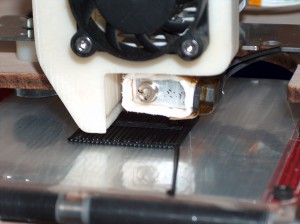In the 80s, I worked for an economic consulting firm and defense contractor in the heart of Washington, DC. We had just landed an important contract in Ohio, and I had been assigned as the systems architect — I would need to move. Invoking the transfer clause in my lease, I terminated the lease in my apartment, moved all my stuff into my car, and prepared to move to Ohio. However, this left me a few days without an apartment working in the old office before I was supposed to report to the office in Ohio.
A friend offered his couch for a few days, except he wouldn’t be back in town until Friday night, and it was Thursday. No problem, one night in a hotel wouldn’t be so bad. Except, not having a lot of money, I figured one night without paying for a hotel would be even better, and hit upon the brilliant idea of spending the night at the office.
Figuring it was better to ask forgiveness than to ask permission and get denied, I thought I’d just avoid getting caught. People must work late all the time, so surely it couldn’t be that bad if I did get caught. At worst, I might get fired and not have to move to Ohio, I thought. I was wrong about that.
Not wanting to prolong the experience, I had a long dinner, and showed up at the office around 10:00 p.m. It was a large office, and the doors were all badged with access cards, except for a small, unmarked side door that took an actual, physical key. Months earlier, I’d been handed the key by the manager of the server room to make it easier to move equipment, and I’d neglected to give it back — quite innocently — but now I wouldn’t have to explain why my card showed up on the entry records so late at night. We did do defense work, after all, and I didn’t want to be mistaken for a spy.
Opening the door quietly, I snuck past the server room and froze, as I saw the beam of a flashlight dancing at the end of the hall. My access card may or may not get me into the server room at this hour, but that would be a lot to explain. I flattened against the wall in a side hall and waited.
The security guard didn’t shine his flashlight down the little dead end I’d stuck myself in, and continued on his way. I figured the safest thing to do would be to go the other way, which would take me away from my cube, where I had originally been headed. While it might be easier to explain why I was sleeping at my own cube at two in the morning, it hardly seemed comfortable, so I headed past the main reception desk.
It was a big glass desk, too open and visible, for my purposes. On the desk there was an etched crystal globe about the size of a baseball which I liked, so I picked it up as a talisman, intending to return it at the end of the night. (At least I was only sort of wrong about that.)
Hearing footsteps from the direction in which the guard went, I left the reception area and ran into the media room just behind it, a large room used for presentations and for impressing guests. I dove and slid quietly across the marble floor under a “history table” that held various awards and stacks of brochures about our company. The table was a lot shallower than I’d hoped. I envisioned the guard’s flashlight beam settling on my backside and my halting attempt to explain just what the hell I was doing there.
Footsteps stopped at the door and I watched the wall light up as a beam scanned the room — it didn’t get below desk height — he clearly wasn’t looking for some idiot hiding under a table. The footsteps moved on, and I breathed a sigh of relief.
One hall connected to the media room led to “mahogany row,” which wasn’t actually mahogany at all, but referred to a set of nicely appointed offices used by the company higher-ups. Perfect, I thought, one of them probably has a couch, and maybe even a bathroom. The hall looped around the front of the office to the reception area, so I wouldn’t be trapped, either.
Unfortunately, it hadn’t occurred to me that most of these offices would be locked with access cards. I walked down the dark hallway, gently pushing a few doors experimentally, but of course they were all locked — some of our work was classified, after all, and not all of it went to the vault every night. I got to the corner office — and couldn’t believe my luck — the door stood open about a hand’s width. I couldn’t see much in the gloom, but I pushed the door open as quietly as I could.
This was Phil’s office, a company vice president. We’d talked a couple of times, but were too far apart on the food chain to take much notice of each other, much less for me to spend any time in his office. His windows were huge, and let enough light in for my dark-adjusted eyes to see more than grey outlines.
My heart jumped — there was clearly a man sitting on the floor, not moving. I followed the man’s gaze to see Phil hanging from his neck from the ceiling behind his desk, his teal tie apparently tied into a noose. The man on the floor stood up very slowly, and I saw that he was looking straight at me. He looked classically Russian; He was a short man, perhaps 5’2″, white, cold blue eyes, and no emotions in his facial expression. In his gloved hand there was a gun, and he was raising it toward me.
My brain “unstuck” and I felt an adrenalin surge, and good advice sprung to my head, unbidden. Your priority is to get away. Then, act, before they think you will. I threw the globe as hard as I could at the man. At the same time, I yelled. At this point, all concerns about evading the security guard melted away — better to be caught and fired than dead.
I should have turned away and just bolted, but I didn’t resist the urge to see where the globe landed. I had aimed at his head (another mistake, I should have aimed for the center of his body) and he tilted his head slightly away from its path, not taking his eyes off me for a moment. The globe crashed into the wall behind him, making a hole and sending up a small cloud of plaster dust. Why are you still here? my brain screamed.
I felt a hand on my shoulder.
I twisted away and down, heading back around toward the reception area, looking only in front of me, and ran. The hallway turned sharply, and I looked back again as I turned, to see the security guard crumpled and the small man stepping over him. (Had I heard a gunshot? I don’t think so, but my heartbeat is loud in my ears.)
In high school, I briefly held the school record for the 100 meter dash, of which I was fairly proud and considered joining the track team. (The next day, my record was shattered by a boy who ran in cowboy boots and who later was selected as an alternate for the Olympics, but that’s beside the point.) As long as I didn’t do anything stupid, that is.
During my brief high-school football career as a wide receiver, I intercepted a pass at the 1 yard line and ran down the field. As I neared the opposite side of the field, I had a horrifying thought: was I running the wrong way? Was anybody chasing me? I imagined both teams standing at the other end of the field, watching me in disbelief as I did something idiotic in front of thousands of people. I slowed down a little and looked back … only to be flattened by the other team. I had run an interception 97 yards and not made a touchdown.
My fellow team members called me “Almost” after that.
I wasn’t going to make that mistake again. I didn’t stop, slow down, or look back as I vaulted down 5 flights of steps and ran down K street. Downtown Washington DC is pretty deserted late at night, so there wasn’t a lot to slow me down. After a few blocks, I stopped running in a straight line and random right and left turns until I was thoroughly exhausted.
At a gas station pay phone (yes, there were such things back then) I called the police. Not wanting to go back to my car or the office, I took a cab to Alexandria and paid for a hotel.
The next day, I went to the office as usual, expecting quite a scene, but oddly — it was business as usual. No police tape, no office buzz, nothing. The globe was back at the reception desk, but was whitish over Eurasia with ground in plaster dust. I detoured through the media room and looked down (now well-lit) mahogany row — every office was open except Phil’s. Closed, but not barricaded or guarded.
Nothing seemed out of the ordinary, and I didn’t dare ask.




